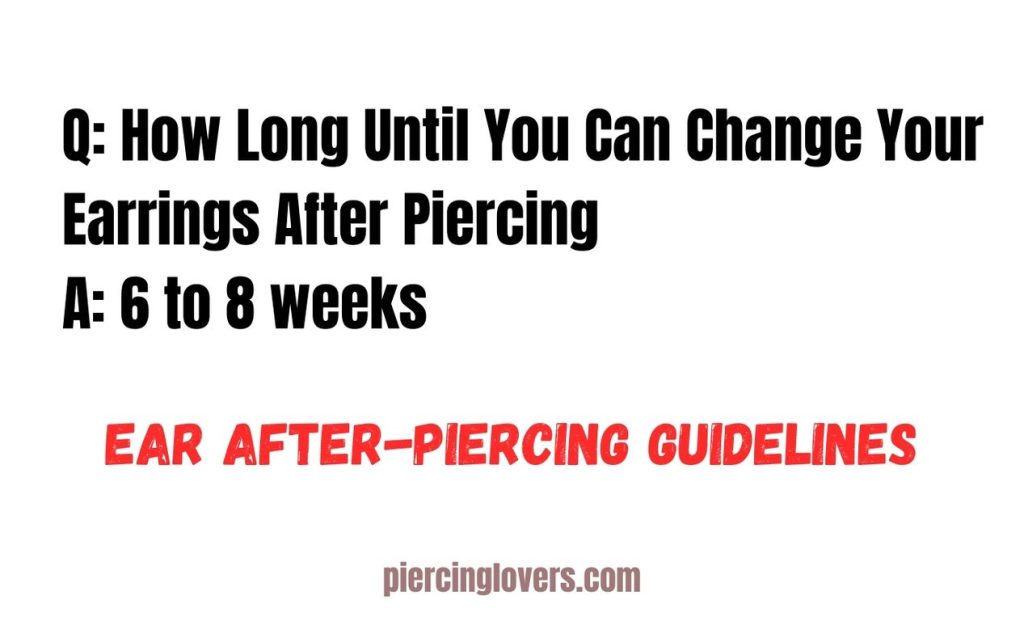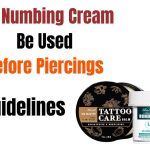So you maybe thinking for ear piercings or already got ear piercings. But you don’t know how long until you can change your earrings after piercing. Well, when you get a new ear piercing, it’s essential to exercise patience and allow your body the time it needs to heal. Generally, experts recommend waiting 6 to 8 weeks before changing your earrings for the first time.
This period is crucial because it allows your piercing to heal sufficiently, minimizing the risk of complications such as infections, irritation, or the piercing closing up. The exact healing time can vary depending on several factors, including the location of the piercing, the type of jewelry used, and the aftercare practices you follow. By adhering to these guidelines, you can know how long after ear piercing can you change earrings. So without wasting more time, lets jump to the article.
Why You Should Wait To Change Earrings After Ear Piercings
The healing process after getting a new piercing is delicate and requires careful attention. Changing your earrings too early can disrupt this process, leading to several potential issues. For instance, early earring changes can introduce bacteria into the still-healing wound, increasing the likelihood of an infection.
Infections can cause significant discomfort, prolong the healing process, and, in severe cases, lead to more serious complications. Even if your piercing appears healed on the outside after a few weeks, the internal tissues might still be vulnerable. Removing or changing earrings prematurely can cause the piercing hole to close partially or entirely, or it may lead to irritation and inflammation.
This, in turn, can extend the healing time and might necessitate a visit to a professional piercer or even a healthcare provider for treatment. Therefore, giving your piercing ample time to heal is essential for avoiding unnecessary complications.
Want To Change, Here Are A Few Signs Your Piercing is Ready for a Change
Before you decide to change your earrings, it’s important to ensure that your piercing is fully healed. Rushing the process can lead to complications, so it’s crucial to look for specific signs that indicate your piercing is ready for new jewelry. Here are the key indicators:
- No Pain or Discomfort: One of the most telling signs that your piercing is ready for a change is the absence of pain or discomfort. The area around the piercing should feel normal, and you should not experience any tenderness when touching or moving the earrings. If you still feel any soreness, it’s best to wait a little longer before making any changes.
- No Swelling or Redness: Initial swelling and redness are normal parts of the healing process, but these symptoms should gradually subside as your piercing heals. If there is no longer any visible swelling or redness around the pierced area, this is a good sign that healing is progressing well.
- No Discharge: During the early stages of healing, it’s common to experience a small amount of clear or slightly white discharge from the piercing. However, by the time your piercing is fully healed, there should be no discharge present. The absence of discharge indicates that the wound has closed properly and is no longer vulnerable to infection.
- Skin Looks Normal: The skin around your piercing should look healthy and normal. It should not be inflamed, discolored, or irritated. If the skin appears smooth and consistent with the surrounding tissue, it’s likely that your piercing has healed sufficiently to change the earrings.
Best Practices for Aftercare To Change Your Earrings In A Short Time
Proper aftercare is not just recommended—it’s essential for ensuring a healthy and quick healing process. How you care for your piercing during the healing phase will greatly influence the outcome. Here are some best practices to follow:
- Clean Regularly: Keeping your piercing clean is one of the most important steps in the aftercare process. It’s recommended to clean your piercing twice daily using a saline solution or an antiseptic specifically recommended by your piercer. Avoid using harsh chemicals like alcohol or hydrogen peroxide, as these can dry out the skin and potentially delay healing. Saline solutions help to gently cleanse the area without irritating the sensitive tissue.
- Avoid Touching: It’s crucial to avoid touching your piercing with unwashed hands. Our hands carry a lot of bacteria, which can easily be transferred to the piercing if touched, leading to infections. If you must touch your piercing, always wash your hands thoroughly beforehand.
- Be Gentle: It’s natural to want to twist or move the earrings occasionally, but during the healing process, it’s best to keep this to a minimum. Excessive movement can irritate the piercing, delay healing, and increase the risk of complications. Be as gentle as possible when cleaning or adjusting your earrings.
- Sleep Carefully: The position you sleep in can affect how well your piercing heals. To avoid putting unnecessary pressure on your piercing, try sleeping on your back or on the side opposite the piercing. This will prevent the earring from pressing against your pillow and potentially causing irritation or discomfort.
Choosing the Right Earrings for the First Change
When the time finally comes to change your earrings, selecting the right pair is crucial to ensuring continued comfort and healing. The type of earrings you choose can make a significant difference in how well your piercing adjusts to the new jewelry. Here are some considerations to keep in mind:
- Hypoallergenic Materials: Opting for earrings made from hypoallergenic materials is highly recommended, especially if you have sensitive skin or are prone to allergic reactions. Materials like surgical steel, titanium, or 14-karat gold are excellent choices because they are less likely to cause irritation. These materials are also durable and resistant to tarnish, making them ideal for new piercings.
- Comfortable Fit: It’s important to ensure that the new earrings are comfortable and not too tight. Tight earrings can compress the tissue around the piercing, leading to discomfort and potentially slowing down the healing process. Choose earrings that fit snugly but allow enough space for your skin to breathe.
- Avoid Heavy Earrings: For your first earring change, it’s best to start with lightweight earrings. Heavy earrings can pull on the piercing and cause stretching or irritation, which can be particularly problematic for a still-healing wound. Once your piercing is fully healed and accustomed to the new jewelry, you can gradually introduce heavier earrings if you prefer.
How to Safely Change Your Earrings After Piercing
When you’re ready to change your earrings, it’s essential to do so with care to avoid damaging the piercing or introducing bacteria. Follow these steps to change your earrings safely:
- Wash Your Hands: Before touching your piercing, make sure to wash your hands thoroughly with soap and water. This step is crucial for minimizing the risk of introducing bacteria to the piercing, which could lead to infection.
- Clean the Piercing: Gently clean the area around the piercing with a saline solution or antiseptic to remove any buildup or debris. This helps to prepare the piercing for the new earrings and ensures that the area is as clean as possible.
- Remove the Original Earrings: Carefully remove the earrings that were initially placed when you got the piercing. Take your time with this step to avoid irritating the area or causing any discomfort. If the earrings feel stuck or difficult to remove, it’s best to seek assistance from a professional piercer.
- Insert the New Earrings: Slowly and gently insert the new earrings, ensuring they glide in smoothly without resistance. If you experience pain, discomfort, or difficulty during this process, stop immediately and consult your piercer for advice. It’s important not to force the earrings in, as this can cause damage to the piercing.
Final Words
So, waiting 6 to 8 weeks before changing your earrings is not just a recommendation—it’s a crucial step in ensuring proper healing and avoiding complications. While it might be tempting to switch out your jewelry sooner, exercising patience will pay off in the long run.
By following the proper aftercare practices, choosing the right earrings, and carefully changing them when the time is right, you can enjoy a healthy, well-healed piercing that will last for years to come. Always consult your piercer if you have any doubts or questions, as they can provide personalized advice based on your specific situation.




